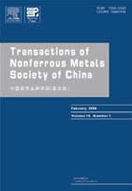Ion coordination affinity and its application in mineral flotation
(1. School of Minerals Processing and Bioengineering, Central South University, Changsha 410083, China;
2. Engineering Research Center of Ministry of Education for Carbon Emission Reduction in Metal Resource Exploitation and Utilization, Central South University, Changsha 410083, China;
3. School of Resources, Environment and Materials, Guangxi University, Nanning 530000, China;
4. State Key Laboratory of Mineral Processing Science and Technology, Beijing General Research Institute of Mining & Metallurgy, Beijing 102628, China)
2. Engineering Research Center of Ministry of Education for Carbon Emission Reduction in Metal Resource Exploitation and Utilization, Central South University, Changsha 410083, China;
3. School of Resources, Environment and Materials, Guangxi University, Nanning 530000, China;
4. State Key Laboratory of Mineral Processing Science and Technology, Beijing General Research Institute of Mining & Metallurgy, Beijing 102628, China)
Abstract: The ion coordination affinities of the commonly found metal ions were evaluated using DFT calculations. The results indicate that the lowest unoccupied molecular orbital (LUMO) energy of metal ions correlates positively with their binding energies with O(S) ligands, and some metal ions with various valence states also present different affinities. Besides, due to the steric hindrance effects, the mono- and hexa-coordinated metal ions may exhibit different affinities, and the majority of the studied hexa-coordinated metal ions exhibit oxophilicity. These affinity differences perfectly illustrate the activation flotation practice in which the oxyphilic ions are applied to activating oxide minerals, while thiophilic ions are applied to activating sulfide minerals.
Key words: ion coordination affinity; mineral flotation; coordination chemistry; density functional theory

